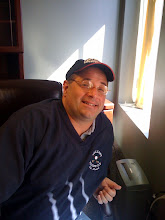The planing and the building of the Golf Cradle mold was an education from its beginning to end. Let me bring you up to speed...my background is in Psychology and Education. I have worked in a High School as a Psychologist since graduating from college. Which is to say, my awareness in the tool and die field was "null." Prior to this project, I had no knowledge (not to say that I have any now) in blue printing and tool/die development. I could not even tell you what a tool and die person did as a job or his level of education.
I was introduced to a company near to my home, Custom Molding Solutions. This is a good size size shop with approximately 20 employees. The two owners, Dwight and Mark, are great people who each have a distinct set of skills that are complimentary. Dwight heads up the office management component and pricing, while Mark coordinates the shop's daily activities. The first step was to create a blue print that the Golf Cradle mold could be build from. The planning of a mold this size was a large undertaking. The concept was to build an injection mold that was a negative of the actual product. Also build into the mold had to be cooling lines, pin placements, etc.
The next step was to order a block of aluminum that measured three by four feet in diameter. It was then cut in half for the milling process to start. This process is also extremely interesting such that the specifications and dimensions of the Golf Cradle are fed into a computer program. The block of steal is then put into the machine and an assortment of drill bits are used to carve out a negative imprint of the Golf Cradle. This mold was considered a "family mold" where four components are produced from one injection, that being the base, two arms, and the swivel bottom.
The process of building and completing the Golf Cradle Mold took approximately two weeks, 24 hour per day. Once the program was fed into the computer, the milling machine runs itself. During this phase, we had one major set back. The motor of the milling machine had to be replaced. A new motor had to be ordered and installed extending the time needed to complete this phase of the project. Once finished however, the outcome was exactly as what I had expected. Other than the time delay, the mold was perfect (I was under a time deadline however, which I will address in a future posting) which yielded four different components to be assembled.
This part of the process is called "secondary assembly." Part of the secondary assembly consisted of two sets of holes to be drilled into the arms and to the base. The arms then have to be attached to the base. The swivel had to be screwed into the base and finally, the sticker placed on the front of the Golf Cradle. Then the assembled Golf Cradle is put into a retail box, sealed, and stacked into a large shipping container. The Golf Cradle is now ready for delivery.
Looking back at it all, the milling and the manufacturing phase was the most rewarding for me. I was able to take an idea, have it put to paper, watch the production of the mold, and finally see a fully assembled Golf Cradle. This was a memorable accomplishment. At that point in time, I had actually thought that the hard work was done.....was I mistaken...
Now please remember, this amazing process,the knowledge, and the skills to produce such a piece of work comes with a hefty price tag....a very large price tag. No blue light special here....However, one of the benefits of having my mold maker being the manufacturer of the Golf Cradle is that they are able to monitor the mold usage (damage) and act accordingly. They are able to address immediate fixes and/or complications. This service is part of the original cost of the mold. Custom Molding Solutions is a one stop shop for fabrication and production. I really do appreciate there continued efforts to work with me on a daily basis.
www.golfcradle.com
Subscribe to:
Post Comments (Atom)

No comments:
Post a Comment